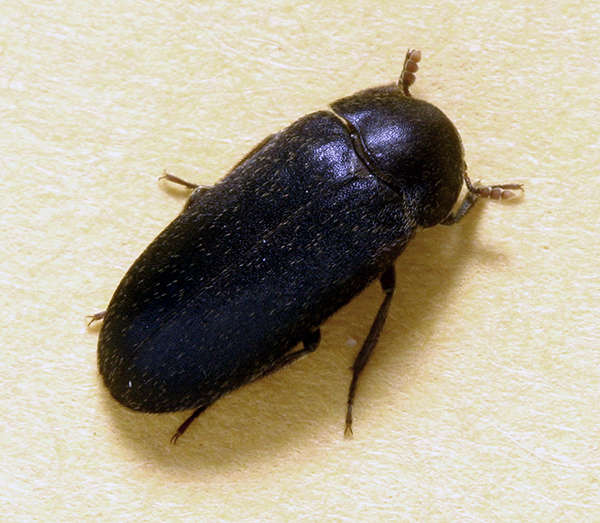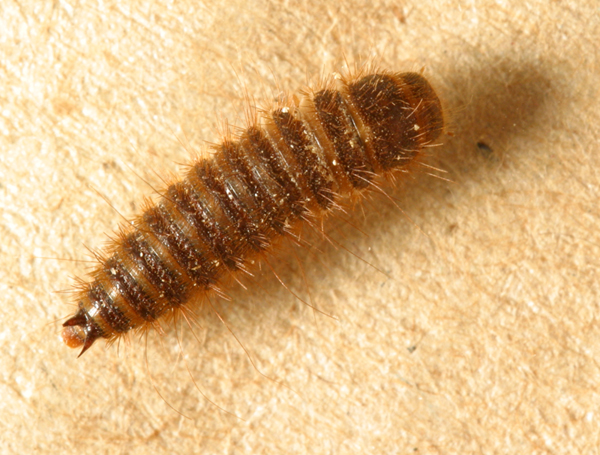
Adult black larder beetles reaches almost 3/8 inch in length. As with all Dermestid beetles the head is pointed downward and not usually visible from above.
Hide and larder beetles are among nature’s most efficient scavengers, feeding mostly on dead animals. Occasionally, however, they become pests of households, where they feed on a wide variety of animal protein-based items. Common foods for these beetles include leather goods, hides, skins, dried fish, pet-food, bacon, cheese, and feathers.
Three of the most common species, the hide, larder, and black larder beetles are known scientifically as Dermestes maculatus, Dermestes lardarius, and Dermestes ater. All three belong to the insect family called Dermestidae, and are related to carpet beetles, a more common group of indoor insect pests. Many Dermestes beetles are cosmopolitan, meaning they are distributed around the world. The hide and larder beetles are thought to have originated in Eurasia; while the black larder beetle is believed to be native to North America.
Identification
Adult Dermestes beetles are relatively large, ¼ to over 3/8 inches-long, and dark brown to black with various markings (right Figure above). Sides of the body are almost parallel, convex, shiny, and moderately hairy. An adult hide beetle is strikingly white on the underside. The hide beetle’s coloration, together with the acutely pointed and saw-like (serrated) tips of the elytra, serve to separate it from other Dermestes species. The larder beetle is easily distinguished by a distinct cream-colored band across the top third of the elytra, sometimes with three small black patches on each side. The black larder beetle is distinguished from the similar hide beetle by the lack of a pointed elytral tips, and by the presence of small patches of white hairs (setae) on the underside of the third and fourth abdominal segments of the male (females have no patches), compared to patches on only the fourth segment of hide beetle males.
Dermestes larvae are cigar-shaped and heavily to completely covered with setae (hairs), giving a fuzzy appearance. They are generally dark brown to black and have a pair of curved, conspicuous “horns” (urogomphi) on the terminal segment of the abdomen.
Adult Dermestes can be distinguished from other dermestid beetles by their relatively large size and lack of a median eye-spot on the head (a character that requires magnification to see). Larval Dermestes are distinguished by the presence of urogomphi on the last abdominal segment.
Damage
Dermestes beetles feed on a wide variety of animal protein-based products and are serious pests in silkworm production and in museums. Common food sources include leather goods, hides, skins, dried fish, pet-food, bacon, cheese, and feathers. Household infestations are sometimes attributed to the presence of bird or rodent carcasses, old bee nests, or accumulations of dead insects. Dermestes may possibly feed on plant material of high protein content, but this is not a preferred food source. Hinton (1945) suggests that when the larder beetle is present in granaries and warehouses containing cacao, dried fruit, etc., it is probably feeding on the bodies and exuviae of other insects. Mature Dermestes larvae also bore into hard substrates such as wood, cork, tobacco, plaster, etc. to pupate. The hide beetle is sometimes used by museums for cleaning bones and skulls.
Biology
Female Dermestes beetles require a continuous supply of water and food to achieve their maximum egg-laying capacities. Provided with dried meat and water, female hide beetles lay more than 300 eggs in their lives. Eggs are laid singly or in small batches on the food source, and hatch within 4 to 6 days. Numbers of instars vary, depending on the temperature and quality of the food source. Optimum temperatures for development are between 64 to 68 degrees F. At 75% RH and 70 degrees F, on a diet of dried meat, the hide beetle passes through 7 to 9 molts and completes its larval development in an average of 50 days. Under these temperature and humidity conditions, the pupal stage lasts 20 to 22 days and adult hide beetles live 169 to 173 days.
Control
Locating and eliminating sources of infestations, as well as good preventive sanitation, are keys to control of Dermestes infestations. Sometimes the presence of hide and larder beetles means that an animal may have died in the structure within the past few months. Look for, and close, possible points of rodent or wildlife entry into the house. Cold storage at temperatures less than 50 degrees F is an effective method for protecting furs and other valuable leather goods. Sticky traps placed on horizontal surfaces will capture mature Dermestes larvae and can help locate infested materials.
For more information about other dermestid beetles and stored product pests, see Pantry and Fabric Pests in the Home, E-486.
